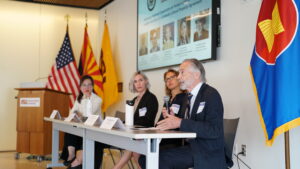The U.S.-Cambodia Cultural Property Agreement: Reflecting on Successes and Advancing Regional Cooperation
July 9, 2025
For more than two decades, the U.S.–Cambodia Cultural Property Agreement (CPA) has served as a model of how cross-border cooperation can protect vulnerable heritage, keep stolen artifacts out of the U.S. market, and safeguard responsible collectors, dealers, and museums.
In 2003, the Royal Kingdom of Cambodia and the United States signed this memorandum of understanding, marking a significant step in the global fight against the illicit trade in antiquities. The agreement commits both nations to working together to combat the looting and trafficking of cultural heritage. It builds on emergency import restrictions first enacted in 1999—as Cambodia was recovering from decades of civil war, genocide, and foreign occupation.

The Antiquities Coalition was proud to join the U.S.-ASEAN Center on June 30 for the panel discussion “Advancing Regional Cooperation to Protect Cultural Heritage: Insights from the U.S.–Cambodia Cultural Property Agreement.” AC Policy Advisor Steve Epstein participated alongside leading voices in cultural heritage protection, including Glen Davis, Director of the U.S. Department of State’s Cultural Heritage Center (CHC); Emma Stein, Associate Curator of Southeast and South Asian Art at the Smithsonian National Museum of Asian Art (NMAA); Annalisa Bolin, Regional Analyst at the Cultural Heritage Center; and Deputy Chief of Mission Oum Socheat of the Royal Embassy of Cambodia to the United States.
Panelists reflected on how the U.S.–Cambodia CPA has advanced both cultural protection and international partnership. In his remarks, CHC Director Glen Davis highlighted the agreement’s success not only in deterring looting and trafficking, but also in fostering cultural exchange. Since its signing, the agreement has helped facilitate the return of over 145 stolen cultural objects, while also laying the groundwork for educational exchanges, long-term object loans, and joint exhibitions—including an upcoming Smithsonian NMAA collaborative exhibition announced during the event.
Deputy Chief of Mission Oum Socheat emphasized the shared responsibility of cultural heritage protection. He praised the CPA for demonstrating that safeguarding heritage is a “two-way street,” and urged that the lessons learned through the U.S.–Cambodia partnership should inspire similar efforts across Southeast Asia, stating,
“The United States also has a responsibility to ensure that its art market is not complicit in the trade of looted artifacts. This lesson may extend across Southeast Asia and beyond. Cambodia’s experience can inform similar efforts in our neighbors’ countries facing loss of heritage through looting and illicit trade.”
Key takeaways:
- The U.S.–Cambodia CPA is a first step toward a broader regional solution for cultural heritage protection.
- The illicit trade in cultural property is a transnational crime and requires a transnational response. CPAs are most effective when adopted across a region, closing backdoor loopholes.
- Regional groups like ASEAN and standard-setting institutions like the Smithsonian NMAA are in full support of these collaborative efforts to protect cultural heritage.
The Antiquities Coalition applauds the United States and the Kingdom of Cambodia for their sustained work to protect cultural heritage for future generations and looks forward to our continued collaboration in the fight against cultural racketeering.
Learn more about CPAs, here.
Follow the work of the U.S.-ASEAN Center.







